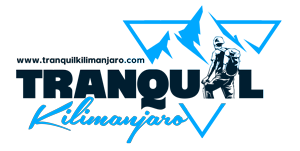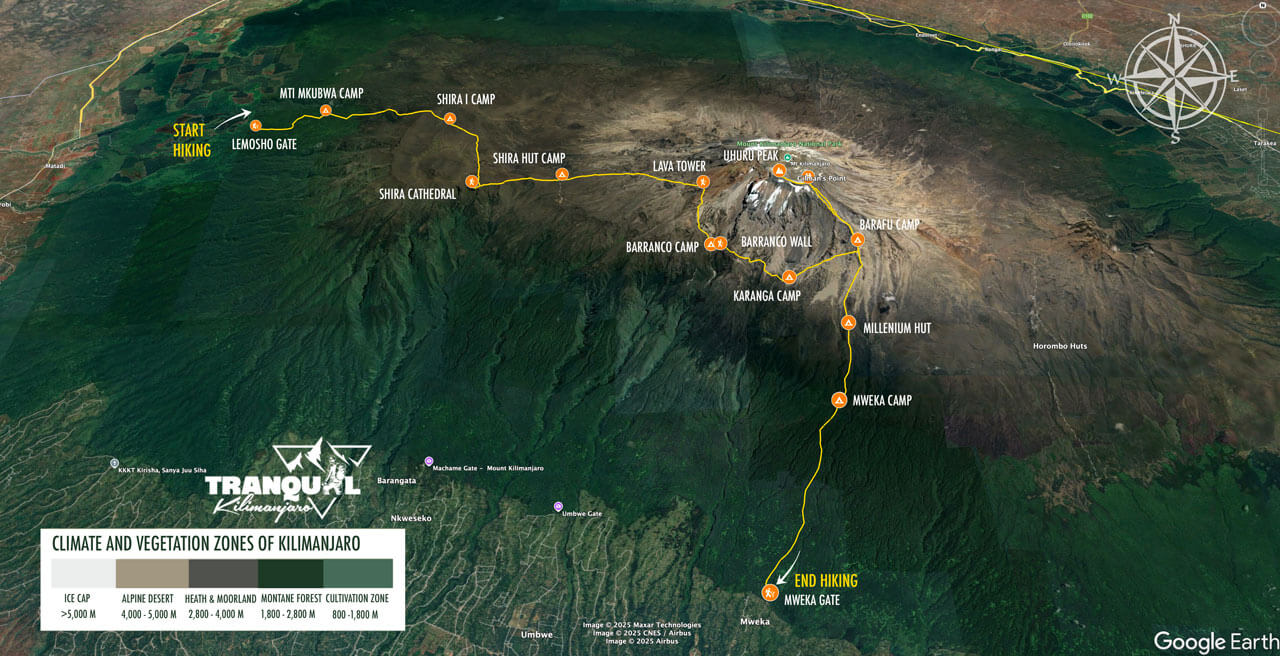Where will you sleep along the Shira Route?
The Shira Route is similar to the Lemosho Route but starts higher at Shira Gate (3,500m). Climbers sleep in tents throughout. The first night is at Shira Camp 1 (3,500m), followed by Shira Camp 2 (3,850m). The route may include a visit to Lava Tower (4,600m) for acclimatisation, though it is not typically used as an overnight camp. Climbers then proceed to Barranco Camp (3,900m), Karanga Camp (3,960m), and Barafu Base Camp (4,670m). Descent is via Mweka Camp (3,100m). All accommodations are in tents, and the higher starting point can affect acclimatisation.
Meals and Snacks on the Shira Route
When trekking the Shira Route, a less common but scenic western approach to Mount Kilimanjaro that starts at a higher altitude on the Shira Plateau, you’ll enjoy a full board dining experience tailored for high-altitude trekking. Professional cooks prepare three hot meals daily, along with snacks and beverages, with menus designed to balance carbohydrates, proteins, and fats to keep you energised. It’s recommended to notify us of any dietary restrictions in advance so that we can accommodate vegetarian and vegan diets. More about Kilimanjaro meals.
Breakfast
Begin your day with a hearty breakfast to fuel your trek across the expansive Shira Plateau. Typical offerings include:
- Porridge with milk – warm and energy-rich
- Boiled or fried eggs – protein to sustain your climb
- Bread or toast with spreads like butter, jam, or peanut butter
- Fresh fruit such as bananas or oranges
- Hot beverages like tea, coffee, or hot chocolate
Served at high-altitude camps like Shira 1 or Shira 2, breakfast provides a nourishing start in the route’s unique moorland setting.
Lunch
Lunch is designed to be portable and nutritious, perfect for refuelling as you navigate the Shira Route’s open landscapes. Expect:
- Sandwiches with fillings like meat, cheese, or egg
- Fresh fruit – a refreshing addition
- Sliced vegetables – light and healthy
- Macaroni with meat sauce – occasionally included for variety
- On some days, particularly at camps like Barranco, a hot lunch may be prepared, offering a warm break during your trek
The Shira Route’s early high-altitude start makes these meals crucial for maintaining energy.
Dinner
After a day of trekking, dinner is a hot, satisfying meal to restore your energy. It typically includes:
- Stews or curries with meat – hearty and flavorful
- Rice or pasta – carb-heavy staples
- Grilled meats – protein-rich options
- Vegetables – essential nutrients
- Bread or chapati as a side
Served at campsites with panoramic views, dinner is a comforting moment to relax amidst the Shira Route’s rugged beauty.
Energy Snacks
To maintain energy levels during hikes across the Shira Plateau and beyond, you’ll have access to snacks throughout the day, including:
- Nuts (e.g., peanuts, almonds)
- Dried fruits (e.g., apricots, raisins)
- Chocolate bars
- Cookies
- Popcorn
- Energy bars
These snacks are ideal for quick energy boosts, especially given the route’s immediate high-altitude exposure.
Vegetarian and Vegan Diets
At Tranquil Kilimanjaro, we can accommodate vegetarian and vegan diets with advance notice. More about vegetarian meals on Kilimanjaro.
- Vegetarian options may include tofu scramble, cheese sandwiches, and lentil curries.
- Vegan options could feature plant-based meals like hummus wraps, vegan chili, and overnight oats with plant-based milk.
The Shira Route’s high-altitude start and scenic campsites are complemented by a well-planned meal schedule, ensuring you’re nourished and ready to tackle the climb to Uhuru Peak!
How to climb the Shira route
How do I prepare for the Shira route?
Depending on your goal any physical training will come on handy. Train more if you want to reach the summit or you can just train normally if your target is to have a short hike to places like the Shira Plateau
Best time to climb the Shira route?
The Shira Route can be accessed every month of the year. Although some months may be wetter, you can use waterproof gear. The best months for climbing the Shira Route fall between the months of January–March and June–October while the less favourable times are the wet months of April, May and November.
What should I pack and what equipment do I need?
Make sure you pack the required gear for climbing Mount Kilimanjaro. You can arrange for you Shira Route climbing gear with us. Click here to see the full Kilimanjaro gear list.
How to get to the Shira Route?
We will pick you up at the airport to your hotel before and after your Shira route climb. Climbers flying from the UK, the US, Australia or Canada, and other parts of the world have many great sources of choosing their flights to Tanzania’s Kilimanjaro International Airport.
What are the climbing requirements for the Shira route?
Careful planning and training are very important. Consider adding an extra day or extra time to your itinerary to combat altitude sickness.
What permits do I need?
All the Shira Route itineraries provided by Tranquil Kilimanjaro are all-inclusive. The permits and entrance fees are for maintaining Mount Kilimanjaro national park and the mountain itself.
What makes the Shira Route so unique, and why choose it?
The Shira Route, often compared to Lemosho, starts at a higher altitude on the Shira Plateau, which can be accessed by vehicle, skipping lower elevations. This feature makes it unique but potentially affects acclimatisation, as starting higher increases altitude sickness risks. It merges with Lemosho or Machame later, offering scenic beauty, but is less popular due to these challenges, suitable for climbers with prior high-altitude experience. For more detailed information about Shira Route, visit www.shiraroute.com.



